Why The Answer to Cancer Might Just Be Within Our Bodies
Introduction
In the field of medical sciences, it is no surprise that most interventions are an attempt to mimic the body’s physiological mechanisms or augment already existing functions.
The human body, fragile as it appears is preloaded with a great percentage of defences it needs even before any threat or danger is encountered by it.
From birth, maternal antibodies begin to play the role of defence until about 6 months when the child can produce it’s own antibodies and immune cells.
The body naturally possesses the machinery to combat attacks made on it by infectious agents e.g viruses, bacteria, fungi and attacks mounted by TUMOUR CELLs.
Tumours
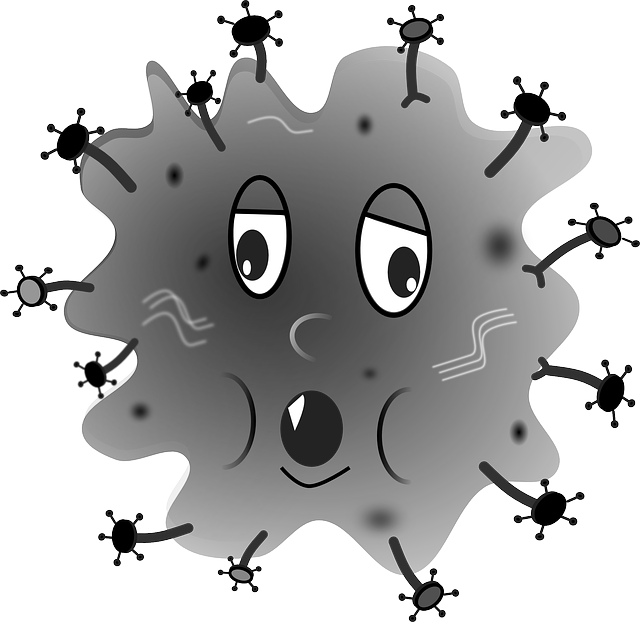
A tumour is an abnormal mass of tissue whose growth and rate of proliferation can be considered as excessive and which also does not conform to the rate of growth of the surrounding normal tissues.
Tumours are caused by numerous agents; some known, some unkown.
A point to note about tumours is that removal of the stimuli does not stop the growth. This abnormal and excessive growth persists even after removal of the stimulus that evoked the change!
Tumours could be classified as either benign or malignant. Benign when it does not invade other tissues and shows no sign of metastasis or spread. Malignant when it invades surrounding normal tissues and shows signs of metastasis.There are a number of differences between these two tumour types. However, the focus of this article is on malignant tumours(cancers) as they are a major cause of death and poor health in our societies.
Brief overview of our immune system
Most times, when the word ‘immune system’ is mentioned, most people begin to think about cells in the body responsible for it’s defence.
It actually begins from our skins, tears, saliva and other mechanisms one would easily ignore.
Two broad classes of the immune system exist. They are;
- Innate/natural immune system
- Adaptive/acquired immune stystem
Innate immune system:
Consists of all mechanisms by which the body fights attacks made on it.
Does not need a previous sensitization to the attacking agents
First line of defence.
Examples include:
- Surface barriers: the skin being the largest.
- Chemical barriers: lysozyme in the saliva/breast/tears, zinc in semen, lactoferrin(an iron containing enzyme in breastmilk)
- Inflammation : it leads to the release of potent chemical agents which destroy infecting organisms or help in mobilizing cells to play specific defensive roles during attacks.
- Cell barriers: white blood cells including macrophages, neutorphils, oesinophils, basophils and NATURAL KILLER CELLS.
Neutrophils fight bacterial attacks,
Eosinophils destroy parasites and worms,
Basophils are important for anaphylactic reactions,
Macrophages eat up(phagocytose) bacterial and other agents while
Natural killer cells destroy all infected human cells and abnormal body cells including tumour cells.
Adaptive immune system:
This consists of two main cell types: B cells and T cells.
B cells are responsible for forming antibodies after being stimulated by the first attack.
T cells on the other hand are responsible for functions including activation of B cells and phagocytes of the innate immune system, regulating other T cells and tumour surveillance/destruction. T cell functions also depend on previous exposure to a threat.
| Innate immune system | Adaptive immune system |
|---|---|
| 1. First line of defence | Second line of defence |
| 2. Non-specific action most times | Actions are usually specific |
| 3. Has no memory | Has Memory |
| 4. Innate immune system provides maximum response within a short time | Adaptive immune system is slowly built and gives long-term defence |
| 5. Requires no previous encounter with threats | It's functionality depends largely on previous encounters with toxic insults. |
For the purpose of this article, the focus will be on the natural killer cells (NKCs)
Natural killer cells(NKCs)
These are a type of cytotoxic(cell destroying) white blood cells critical to the innate(natural) immune system.
NKCs provide rapid responses to viral-infected cells which usually takes a period of 72 hours after infection. They also play a crucial role in tumour cell lysis. NK cells have the natural ability to recognize stressed cells. They are considered unique in the sense that they need no MHC molecules to identify damaged or stressed cells and neither do they wholly depend on other immune cells for their functioning. MHCs are proteins found on cell surfaces and are normally used by cells of the adaptive immune system for recognition of dysfunctional cells which also includes tumour cells.
Some really smart tumours can alter MHC and hence appear invisible to MHC dependent tumour-killing immune cells like the Killer T cells of the adaptive immune system.
Fortunately, natural killer cells do not wholly depend on MHCs for tumour identification.
Wikipedia: the role of NK cells in both the innate and adaptive immune responses is becoming increasingly important in research using NK cell activity as a Potential Cancer Therapy
The NCR(Natural cytotoxicity receptor) of NKCs
These Receptors are molecules on the surface of NKCs which enables them to react in any given situation involving tumour cell destruction.
NCRs are the most important receptors with regards to tumour cell lysis. They bind to chemical substances from tumour cells which are usually associated with tumour growth.
By activating these receptors, the NKCs can either cause direct death to the tumour cell or release substances to recruit macrophages to its aid.
How NKCs kill tumour cells
- Antibody-dependent cell-mediated cytotoxicity
A process whereby antibodies which have bound to tumour cells are recognized by NKCs via a certain receptor(CD16) resulting in activation and release of molecules which destroy the dysfunctional cells. - Cytotoxic granule Mediated cell apoptosis
Apoptosis is simply a programmed cell death. NKCs possess potent lytic substances; Perforin and Proteases like granzyme which destroy cells recognized as tumours.
The "Missing self" Hypothesis
This was proposed in an attempt to understand the functioning of NKCs in the body.
NKCs have killer cell immunoglobulin receptors (KIR) which recognize MHCs on normal body cells and hence prevents destruction of those cells. These KIRs are termed inhibitory receptors. In the absence of MHCs("missing self") which is typical of viral infections and tumour cells, KIRs are not functional and hence NKCs have a "go ahead and kill'em all" command.
The diagram below depicts it well.
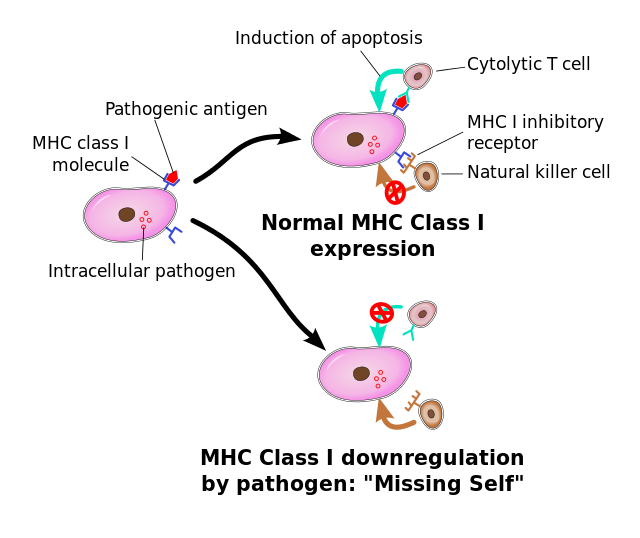 Image Source
Image Source
Why NKCs are good for the Tumour Killing Job?
- They are specific for tumour cells as they naturally recognise them.
- They are rapidly acting cells as they need no MHCs for tumours recognition.
- They are effective in killing cells involved.
- They cause no adverse effects compared to classical chemotherapy/radiotherapy or surgery.
- NKCs cannot be infected by HIV compared to killer T-cells, a subset of T cells involved in tumour cell destruction.
Research into the use of NKCs as Cancer Therapy
Natural killer cells make up a small percentage of human peripheral blood mononuclear cells. They represent 5-20% of peripheral blood lymphocytes.
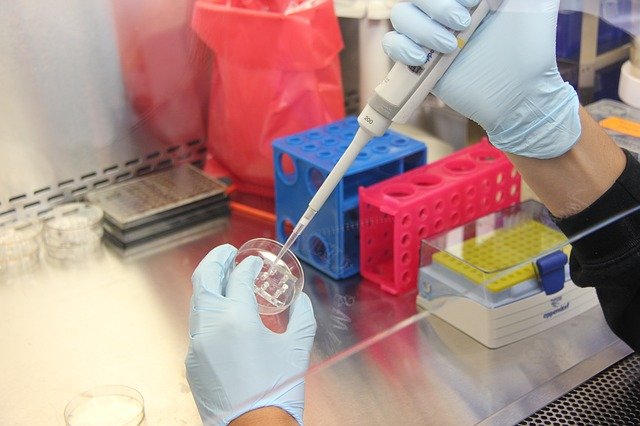
Source
The small fractions occupied by NKCs have made studies on them difficult. In April 2013 Issue of clinical and experimental Immunology, Wang et aldescribed an invitro method for expanding the population of NKCs. This involved stem cell harvesting and propagation with Interleukin-2 which stimulated these cells to grow into NKCs.
NKCs expanded from less than 30% to Over 85% in 7 days and up to 95% within 21 days. It was also noted that NKCs functionality were enhanced invitro.
Wikipedia: Clinical studies/trials have shown it to be well tolerated and some anti-tumour responses have been seen in patients with lung cancers, melanomas and lymphoma.
Draw Backs
- The production of huge numbers of the cells may be difficult,expensiveand time consuming.

Source - Evasion by some tumour cells: Despite the ability of NK cells to detect tumours who have altered MHCs, some tumour cells release substances as decoy molecules which enables them avoid immune responses. This is usually seen in prostate cancer.
Although the problems of tumour evasion may be someday overcome by modern bio-technological approaches, NKCs as chemotherapy may not be desired due to it's failure to combat the one of the most well known malignancies of Men(prostate cancer)
However, there is proof that the cure to cancer lies within our bodies
References
[1]https://en.m.wikipedia.org/wiki/Natural_killer_cell
[2]https://www.researchgate.net/post/Best_NK_cell_expansion_protocol_from_PBMCs
[3]https://www.ncbi.nlm.nih.gov/pmc/articles/PMC4826432/
[4]https://www.cancer.gov/publications/dictionaries/cancer-terms/def/natural-killer-cell
[5]https://technical.sanguinebio.com/expansion-of-nk-cells-from-human-pbmc/
[6]https://en.m.wikipedia.org/wiki/Immune_system
Images
All Images are of public domain and are well cited.
Authored by @wordswithhoney
Feel free to comment.
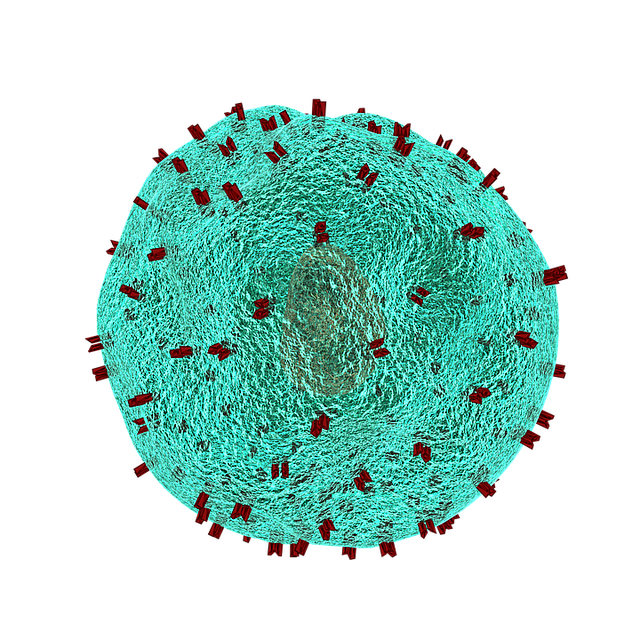
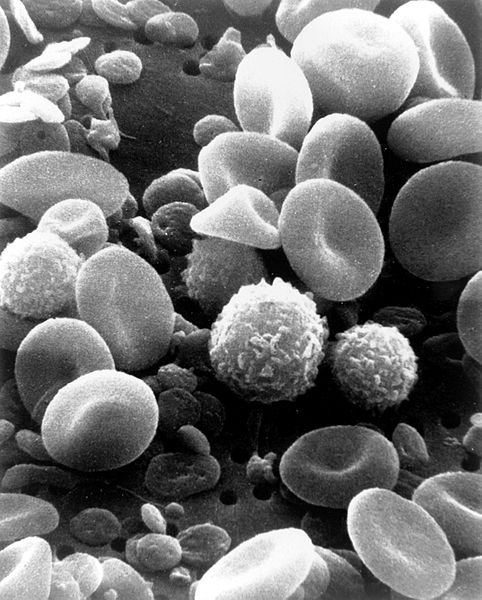
This is a good review of NKC. Though given the fact that NK cells adoptive transfer is not bound to requirement to be dervived from self unlike CD8 cells used in immunotherapy makes them a cheaper choice. This also overcomes the difficulty of lower proportion you described. That is because you can use iPSc to make NK cells. Li et al last month actually demonstrated this in mice. Infact they made CAR NK cells from iPSc just like those CAR T cells used in adoptive immunotherapy. Both the cells were derived from Humans , but NK cells dervived from human iPSc showed least side effects , plus they were equally as potent as CAR T cells. (Though I won't call it best test for potency as a better comparison would have been with mice derived CAR T, but as far as non requirement of being derived from self is concerned it was a good test). Also using CAR modified NK cells might be a better idea than just proliferating NK cells in vitro and injecting them.
IMO the major drawback of NK cells at least in comparison with other formats of immunotherapy lies in their rapid inactivation by TRegs and may require extra IL2 modulation. Then there are some reports on context dependent role of NK cells in graft rejection scenario. Which may be counterintuitive to li et al finding. Nevertheless, as pre-clinical trials are already in progress that would come out soon.
However it is done, I need a cure for cancer ASAP.
This post has been voted on by the steemstem curation team and voting trail.
There is more to SteemSTEM than just writing posts, check here for some more tips on being a community member. You can also join our discord here to get to know the rest of the community!
Hi @wordswithhoney!
Your post was upvoted by utopian.io in cooperation with steemstem - supporting knowledge, innovation and technological advancement on the Steem Blockchain.
Contribute to Open Source with utopian.io
Learn how to contribute on our website and join the new open source economy.
Want to chat? Join the Utopian Community on Discord https://discord.gg/h52nFrV
Has anyone developed any artificial things like nano bots to repair like in Sci fi movies. If so disease is history. Still we don't know how actually communication going on within. If we could crack it we could manipulate it. In future if the environment is harsh either we need to artificially make defences or let nature select the best species